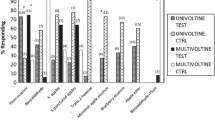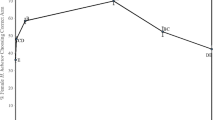Abstract
Many hymenopteran parasitoids are known as biocontrol agents, such as Anisopteromalus calandrae (Howard) (Hymenoptera: Pteromalidae), which is known to parasitize larvae and pupae of coleopteran pests including Lasioderma serricorne (Fabricius) (Coleoptera: Ptinidae). The success of these parasitoids is related to their searching ability, which is mediated through chemical stimuli of the habitat, food, and the progeny of the host itself. This study aimed to assess the chemotaxic responses of A. calandrae comparing the reproductive state of the insects and the experience of wasp females, to different development stages (larvae and pupae) and the presence or absence of the host diet. The chemotaxic responses of A. calandrae individuals at 2 to 4 days old were assessed in a “Y” type olfactometer. Virgin and paired females (without and with previous experience of parasitism) were exposed to larvae of last instar contrasted with pupae and to the diet of L. serricorne. Both virgin and mated males were tested only for diet. Virgin females showed a preference for the diet in contrast to the larvae and to the pupae in contrast to the diet. Paired females without experience choose larvae over diet and made no distinction between pupae and diet. Experienced mated females showed preference for the host to which it had access before, instead of any other alternative option, indicating that there may be changes in the preference through learning.








Similar content being viewed by others
References
Arbogast RT, Mullen MA (1990) Interaction of maize weevil (Coleoptera: Curculionidae) and parasitoid Anisopteromalus calandrae (Hymenoptera: Pteromalidae) in a small bulk of stored corn. J Econ Entomol 83:2462–2468
Athié I, de Paula DC (2002) Insetos de grãos armazenados: aspectos biológicos e identificação, 2nd edn. São Paulo, Varela Editora, 244 p
Ayres M, Ayres MJR, Ayres DL, dos Santos AS (2007) BioEstat 5.0 aplicações estatísticas na área das ciências biológicas e médicas. Belém, Sociedade Civil Mamirauá/CNPq, 324 p
Belda C, Riudavets J (2010) Attraction of the parasitoid Anisopteromalus calandrae (Howard) (Hymenoptera: Pteromalidae) to odors from grain and stored product pests in a Y-tube olfactometer. BioControl 54:29–34
Belda C, Riudavets J (2012) Reproduction of the parasitoids Anisopteromalus calandrae (Howard) and Lariophagus distinguendus (Förster) on arenas containing a mixed population of the coleopteran pests Sitophilus oryzae and Rhyzopertha dominica. J Pest Sci 85:381–385
Darwish E, El-Shazly M, El-Sherif H (2003) The choice of probing sites by Bracon hebetor Say (Hymenoptera: Braconidae) foraging for Ephestia kuehniella Zeller (Lepidoptera: Pyralidae). J Stored Prod Res 39:265–276
Dukas R (2008) Evolutionary biology of insect learning. Annu Rev Entomol 53:145–160
Germinara GS, de Cristofaro A, Rotundo G (2016) Electrophysiological and behavioral responses of Theocolax elegans (Westwood) (Hymenoptera: Pteromalidae) to cereal grain volatiles. Biomed Res Int:1–8
Godfray HCJ (1994) Parasitoids: behavioral and evolutionary ecology. In: Krebs JR, Clutton-Brock T (eds) Monoraphs in behavior and ecology. Princeton University Press, New Jersey 461p
Guertin DS, Ode PJ, Strand MR, Antolin MF (1996) Host-searching and mating in an outbreeding parasitoid wasp. Ecol Entomol 1:27–33
Hilker M, McNeil J (2008) Chemical and behavioral ecology in insect parasitoids: how to behave optimally in a complex odorous environment. In: Wajnberg E, Bernstein C, van Alphen J (eds) Behavioral ecology of insect parasitoids. Blackwell Publishing, New York
Li Y, Dickens JC, Steiner WWM (1992) Antennal olfactory responsiveness of Microplitis croceipes (Hymenoptera: Braconidae) to cotton plant volatiles. J Chem Ecol 18:1761–1773
Loeck AE (2002) Praga de produtos armazenados. EGUFPEL Editora, Pelotas 113 p
Lorini I, Krzyzanowski FC, França-Neto JB, Henning AA, Henning FA (2015) Manejo integrado de pragas de grãos e sementes armazenadas. Embrapa, Brasília 81 p
Mair MM, Ruther J (2019) Chemical ecology of the parasitoid wasp genus Nasonia (Hymenoptera, Pteromalidae). Front Ecol Evol 7
Mbata GN, Eason J, Payton ME, Davis MF (2017) Putative host volatiles used by Habrobracon hebetor (Hymenoptera: Braconidae) to locate larvae of Plodia interpunctella (Lepidoptera: Pyralidae). J Insect Behav 30:287–299
Meiners T, Peri E (2013) Chemical ecology of insect parasitoids: essential elements for developing effective biological control programmes. In: Wajnberg E, Colazza C (eds) Chemical ecology of insect parasitoids. Wiley-Blackwell, Oxford
Meirelles AP, Carneiro TR, Fernandes OA (2009) Efeito de diferentes fontes de carboidrato e da privação de alimento sobre aspectos biológicos de Telenomus remus Nixon (Hymenoptera, Scelionidae). Rev Bras Entomol 53:457–460
Menon A, Flinn PW, Dover BA (2002) Influence of temperature on the functional response of Anisopteromalus calandrae (Hymenoptera: Pteromalidae), a parasitoid of Rhyzopertha dominica (Coleoptera: Bostrichidae). J Stored Prod Res 38:463–469
Rojas JC, Castillo A, Virgen A (2006) Chemical cues used in host location by Phymastichus coffea, a parasitoid of coffee berry borer adults, Hypothenemus hampei. BioControl 37:141–147
Scholler M, Prozell S (2002) Response of Trichogramma evanescens to the main sex pheromone component of Ephestia spp. and Plodia interpunctella, (Z,E)-9,12-tetra-decadenyl acetate (ZETA). J Stored Prod Res 38:177–184
Steidle JLM (2000) Host recognition cues of the granary weevil parasitoid Lariophagus distinguendus. Entomol Exp Appl 95:185–192
Steidle JLM, Scholler M (1997) Olfactory host location and learning in the granary weevil parasitoid Lariophagus distinguendus (Hymenoptera: Pteromalidae). J. Insect Behav 10:331–342
Tognon R, Sant’Ana J, Redaelli LR, Meyer AL (2018) Is it possible to manipulate scelionidae wasps’ preference to a target host? Neotrop Entomol 47:689–697
Vargas CC, Redaelli LR, Sant’Ana J, Morais RM, Padilha P (2017) Influência da idade do hospedeiro e da aprendizagem no comportamento quimiotáxico e no parasitismo de Trichogramma pretiosum. Iheringia Ser Zool 107:1–7
Vet L, Dicke M (1992) Ecology of infochemical use by natural enemies in trophic contexto. Annu Rev Entomol 37:141–172
Vet L, Groenewold AW (1990) Semiochemicals and learning in parasitoids. J Chem Ecol 16:3119–3135
Vilela EF, Della Lucia TMC (2001) Feromônios de Insetos: biologia, química e emprego no manejo de pragas, 2nd edn. Ribeirão Preto, Holos Editora 206 p
Vinson SB (1976) Host selection by insect parasitoids. Annu Rev Entomol 21:109–133
Vinson SB (1998) The general host selection behaviour of parasitoid Hymenoptera and a comparison of initial strategies utilized by larvaphagous and oophagous species. BioControl 11:79–96
Wajnberg E, Colazza C (2013) Chemical ecology of insect parasitoids (eds), Wiley-Blackwell, Oxford 328 p
Acknowledgments
The authors would like to thank Paula Nicolay for the assistance in text review and Camila Corrêa Vargas for the assistance with the statistical analysis, and the National Council for Scientific and Technological Development (CNPq) for the master’s degree and DTI-C (306435/2015-2) scholarships granted to the first author.
Author information
Authors and Affiliations
Contributions
Eduarda Bender, Simone Mundstock Jahnke, and Andreas Köhler planned this work; Eduarda Bender executed the experimental work; Eduarda Bender and Simone Mundstock Jahnke conducted the data analyses; and Eduarda Bender, Simone Mundstock Jahnke, and Andreas Köhler wrote the manuscript.
Corresponding author
Additional information
Edited by Andres Gonzáles – Univ de la República, Uruguay
Publisher’s Note
Springer Nature remains neutral with regard to jurisdictional claims in published maps and institutional affiliations.
Rights and permissions
About this article
Cite this article
Bender, E., Jahnke, S.M. & Köhler, A. Chemotaxic Responses of Anisopteromalus calandrae (Howard) (Hymenoptera: Pteromalidae) to Odors of Larvae, Pupae, and the Diet of Lasioderma serricorne (Fabricius) (Coleoptera: Ptinidae). Neotrop Entomol 49, 171–178 (2020). https://doi.org/10.1007/s13744-019-00742-0
Received:
Accepted:
Published:
Issue Date:
DOI: https://doi.org/10.1007/s13744-019-00742-0




